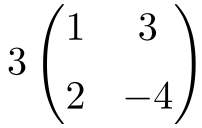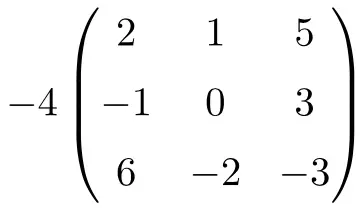On this post we explain how to multiply a matrix by a scalar (number). You will see examples of scalar multiplications of matrices that will help you understand it perfectly and solved exercises so that you can practice. You will also find all the properties of the product of a scalar and a matrix.
Table of Contents
How to multiply a matrix by a matrix?
To multiply a matrix by a scalar, multiply each element of the matrix by the scalar.
Note that when we work with matrices we refer to numbers as scalars, therefore, multiplying a matrix by a scalar means multiplying a matrix by a real number.
Example of a multiplication of a matrix by a scalar
Once we have seen how to do a scalar multiplication of matrices, let’s see an example of this type of matrix operation:

As you can see, to solve the product of a scalar and a matrix, you simply have to multiply each entry of the matrix by the scalar.
Having seen this type of matrix operation, you can now learn how to calculate a multiplication of matrices.
Practice scalar multiplication of matrices
Problem 1
Find the following scalar multiplication:

To calculate the multiplication of a scalar by matrix we have to multiply each entry of the matrix by the scalar:
Note that the matrix before performing the scalar operation was a square 2×2 dimension matrix, and so is the result of the operation.
Problem 2
Calculate the following multiplication of a matrix by a scalar:

The result of the multiplication of the 3×3 square matrix by the scalar is:
Note that the dimension of the matrix remains the same after performing the operation.
Problem 3
Multiply the following rectangular matrix by the scalar -2:
The result of the scalar multiplication is:
Problem 4
Perform the following additions and scalar multiplications of matrices:

See how to add matrices.
It is an operation that combines two products of scalar and matrices and a sum of matrices of order 2. Thus, we must first solve the scalar multiplications of matrices:
And then we add the resulting matrices:
Problem 5
Given the following square matrices of order 3:
Calculate:
It is an operation that combines scalar multiplication together with addition and subtraction of 3×3 matrices. Furthermore, matrix I is the identity matrix, which is composed of 1 on the main diagonal and 0 the remainder of the elements:
Therefore, we first do the multiplications:
Secondly, we solve the addition of the first two matrices:
Finally, we perform the matrix subtraction:
Properties of scalar multiplication of matrices
There are many types of matrices: square matrices, triangular matrices, the identity matrix, symmetric and antisymmetric matrices,… But, fortunately, all the properties of the product of numbers and matrices work for all kinds of matrices.
So these are the properties of matrix scalar multiplication:
- Associative property: when two or more scalars are involved in a scalar multiplication of matrices, we can first multiply the scalars and then the result by the matrix.
Look at the following two operations as they give the same result, regardless of how we multiply scalars 2 and 3:
- Distributive property (addition of scalars): adding two scalars and then multiplying the result by a matrix equals to multiply each scalar by the matrix and then adding the results.
As you can see in the example below, adding 1+2 and then multiplying it by a matrix is the same as multiplying the same matrix separately by 1 and by 2 and then adding the results:
- Distributive property (addition of matrices): adding two matrices and then multiplying them by a number is equivalent to multiplying the two matrices separately by the same number and then adding the results.
You can check this property of the scalar multiplication of matrices with the following example:
- Neutral element property: the multiplication of any matrix by scalar 1 results in the same matrix.
Therefore, when multiplying a matrix by 1 we do not modify the matrix:
Other matrix operation related to multiplication, and that is very useful, is the power of a matrix. Here you will find how compute the power of a matrix and what it is for.